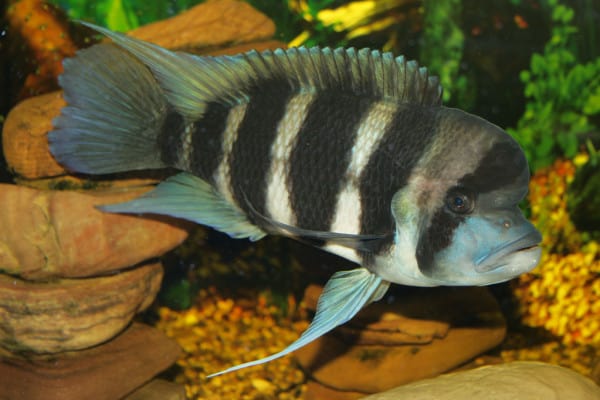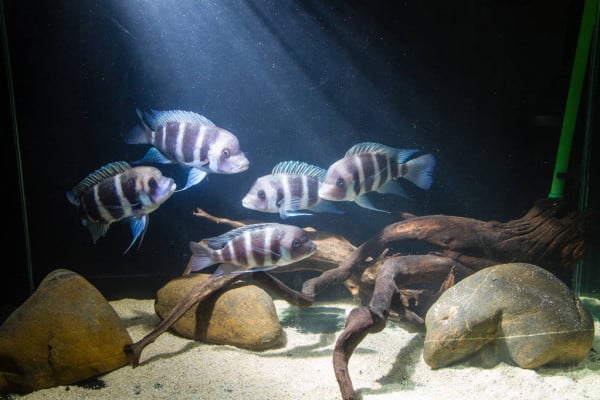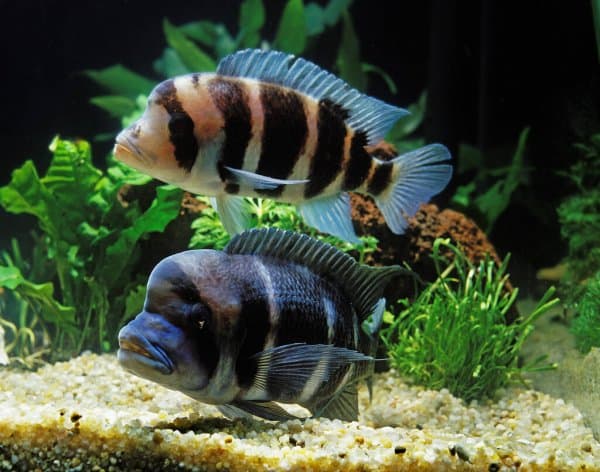The Frontosa Cichlid is an especially dramatic freshwater fish that grows up to 14 inches in length as an adult! Despite their large size and cichlid temperament, they are fairly peaceful towards any tank mates they can’t eat. They also get along even one another in close quarters, which is rare for such a large cichlid.
As a large, social cichlid, you’ll need to have the right tank size for a harem of Frontosa fish and their tank mates. If keeping a single male, 75 gallons is the minimum tank size for one. But a group should be kept in an aquarium around 125 to 150 gallons in size. A smaller tank size may cause territorial squabbles since subdominant fish can’t escape the attention of a dominant male.
They are large but elegant, with striking dark bars, cream and blue tones, and a distinctively humped head. Hence the alternative common name of “humphead cichlid.” Cyphotilapia frontosa is the Latin name, which also describes their cranial shape; Cypho describes their head, tilapia being a type of cichlid, and frontosa describes its size! There is only one other species in the genus Cyphotilapia; the slimmer Cyphotilapia gibberosa, which is much rarer but similar in Frontosa care!
Frontosa Cichlid Care Requirements
| Common Names: | Frontosa Cichlid; Humphead Cichlid |
| Scientific Name: | Cyphotilapia Frontosa |
| Origin: | Lake Tanganyika, East Africa |
| Adult Size: | 12 to 14 inches |
| Diet: | Carnivorous |
| Temperament: | Peaceful to Semi-Aggressive; Predatory |
| Aquarium Size: | 75 gallons for a single male; 125+ gallons for a group |
| Water Conditions: | Hard, Alkaline Water Chemistry |
| Ease of Care: | Moderately Difficult |
| Lipespan: | 15 to 25 Years |
Frontosa Varieties
Like many rift lake cichlids, Frontosa fish come in regional variants that have slight or significant differences in size, shape, and color. These differences can also increase the price, especially for wild-caught fish found in hard-to-reach places.
The Burundi Frontosa Cichlid or Burundi Six Stripe Frontosa is the type you see the most often in the hobby. They are usually sold simply as “Frontosa Cichlid.” the Zaire Blue Frontosa, with its deep blue body, is rarer and often much more expensive than the others.
Other noteworthy varieties include the Zambian Blue Frontosa, Southern Frontosa, and Tanzanian Seven Stripe Frontosa. All of these Frontosa varieties have different blue coloration but identical care requirements. But special varieties are much more likely to be wild-caught or F1 (one generation removed from the wild), which are not as used to aquarium life. You’ll need to be much more careful when acclimating these fish to your aquarium, using drip acclimation and other slow processes.
Lake Tanganyika: the Home of Frontosa Cichlids

The Frontosa Cichlid is found exclusively in Lake Tanganyika, one of the world’s oldest, deepest, and second-largest lakes. Only Lake Baikal, in Russia, is older, deeper, and holds more water. Lake Tanganyika is one of the largest of a series of African rift lakes found in the eastern part of the continent.
Each of the large lakes is home to a collection of African cichlids found nowhere else on earth. Collectively known as rift lake cichlids, these fish have evolved from just a few species that found their way to each lake into hundreds of different, brightly colored fish. Many are predators of other fish, while others eat only algae, invertebrates, or other specialized food sources.
Cichlids from Lake Malawi are very popular, especially the small but highly aggressive Mbuna. But the Frontosa Cichlid comes from Lake Tanganyika, which is similar in some respects but very different from both Lake Malawi and just about every other body of water on earth!
Frontosa Cichlid Water Chemistry
Lake Tanganyika has some interesting differences from the other rift lakes that you’ll need to take into account when keeping Frontosa fish. In their natural habitat, Tanganyikan cichlids live in water that’s three times as salty as Lake Malawi; and six times as salty as Lake Victoria! This is due to the much greater age of Lake Tanganyika. Water has had a chance to enter and evaporate, leaving behind higher levels of salts and minerals.
When filling an aquarium for the first time, you’ll need to use a water conditioner that adds these salts to your tank because they aren’t found in tap water. You’ll also need to provide extra sources of minerals that help buffer the water constantly towards alkalinity, which we’ll discuss more in aquascaping for Frontosa fish! Just remember that these salts don’t disappear with evaporation, so you should top off the tank with fresh, unmineralized water to counter evaporation. It’s only when performing water changes that you need to remineralize incoming water.
Don’t use iodized table salt, by the way, as a mineral additive for Frontosas. For one, iodine isn’t necessary for them. Also, table salt (sodium chloride) is just one of the salts that Frontosa fish need. They also need magnesium, potassium, and calcium salts that a Lake Tanganyika or general rift lake mineral additive provides.
We recommend Cichlid Lake Salt.
As tropical fish that live very close to the equator, Tanganyikan and Malawi cichlids need continually warm and stable temperatures throughout the year. They prefer a range of 74-80 Fahrenheit, with normal to high levels of dissolved oxygen. This continual stability can make Frontosas a little sensitive compared to other freshwater fish, especially wild-caught specimens. You’ll want to acclimate these extremely carefully.
Once fully acclimated, Frontosa fish are very durable fish and not too sensitive to slightly elevated levels of ammonia, nitrite, and nitrate, and other signs of poor water quality. But you should always keep up with water changes and use canister filters for these large fish. As predators, they create loads of ammonia and other wastes, which makes ensuring high water quality a constant challenge.
They can also be shocked by sudden variations in hardness, salinity, temperature, and nitrogenous waste, much like saltwater coral reef fish (which also come from an extremely stable environment). In fact, this is true of wild-caught Tanganyika cichlids in general.
Aquascaping for Frontosa Cichlids
When caring for the Humphead Cichlid, something to keep in mind is that they love doing their own aquascaping. Large cichlids love nothing more than to shift the substrate around, uprooting plants and creating small holes in the landscape. They do this to delineate their territorial boundaries and prepare areas for spawning.
Fortunately, the aquascape for a Frontosa tank should remain fairly minimal since the African rift lakes feature mostly stony and sandy expanses with few to no plants anyway. Also, the extremely hard water is tough for anything but the toughest plants to survive in.
Cave formations are essential for Frontosas. While they are top predators of the lake they can be quite shy and retiring at times. You should also keep the light levels fairly low – or provide several caves if you’re going to keep lighting intense. Frontosa Cichlids are found in the deeper portions of Lake Tanganyika. They rise to the surface at dawn and dusk to feed on smaller fish and then return to the depths as the sun rises.

Many aquarists also use aragonite sands, crushed coral, or other substrates that contain pH buffering minerals. This way, you can keep the pH close to 8.1-8.4, which they prefer. PH buffering agents help keep the water chemistry not only alkaline but help promote stability, which is equally important for Frontosa cichlids. Crushed coral is a little harder for Frontosas to dig in but tends to stay in place better than coral sand will.
Rocks are often rich in minerals that provide the same function. Limestone and marble are two popular choices for aquascaping a rift lake community tank for this reason: they leach mineral salts into the water to counteract any acids that form. Rocks also provide caves and other spaces for fish to hide on occasion.
Since we want the pH to remain both elevated and constant, driftwood should be kept to a minimum. Driftwood contains humic acids and other plant substances that push the pH down towards acidity. If you’re determined to keep plants in these conditions, you can try Anubias (Anubias sp.) and Java Fern (Microsorum pteropus). These plants are hardy, low light tolerant, and are tough epiphytes, meaning they grow attached to hard surfaces like rocks rather than grow roots into the substrate. Once fully acclimated, they are almost impossible for even a determined male Frontosa to remove (though they may bite leaves on occasion).
Feeding Frontosa Cichlids
Frontosas are predators, which makes both feeding and choosing tank mates a little more complicated than usual. Many aquarists offer feeder fish to their Frontosa cichlids. But unless you’re raising your own continual supply, this is actually one of the worst things you can do. Pet store feeder fish are almost always very poor quality. They are raised in dirty, crowded conditions where diseases proliferate. Feeding these fish to your Frontosas is a great way to introduce intestinal worms, ich, and other parasites into your tank.
Instead, I recommend providing your Frontosa cichlid with a diverse spread of protein-rich prepared, fresh, and frozen food. A high-quality predator formula should form the base of their diet. And by high-quality, I mean it should have fish or shellfish protein as the first main ingredient. Many fish food formulas use wheat germ, potato starch, and other cheap fillers that are indigestible to Frontosa cichlids and other predators. Look for salmon, shrimp, and other ingredients.
Frontosas should also be given freshly thawed seafood like chopped shrimp, squid, and white fish like perch. Stay away from terrestrial meat like chicken and beef, which are too high in fat for fish and contain the wrong nutrient profiles.
Tank Mates for Frontosa Cichlids
Choosing tank mates for a Frontosa cichlid can be a little difficult because they are both large and peaceful. Many Malawi and Tanganyikan cichlids tend to be more aggressive and territorial, which makes them poor tank mates despite their love for the same water conditions. And fish that are too small may end up being part of the Frontosa cichlid diet!
I recommend choosing some sort of dither fish when keeping Frontosas because it helps them feel more secure in the open. Dither fish tend to be smaller, schooling, and swim out in the open. This signals to other fish that there are no predators or other dangers lurking nearby, encouraging them to leave their hiding places.
Good dither fish for Frontosas are large, peaceful, and don’t mind living in the mineral-rich, alkaline water that they prefer. This makes the selection fairly small, unfortunately, which is why many Frontosa keepers simply keep their fish alone. But you can try larger rainbowfish, such as adult Red Rainbowfish (Glossolepis incisus). These beautiful fish grow to be 8 inches long; too large to be eaten by a Frontosa Cichlid.
Some of the more peaceful African cichlids also make good tankmates, including the solid blue Malawi Blue Dolphin (Cyrtocara moorii). Large, peaceful bottom-dwelling fish like Clown Loaches and Plecostomus are also great companions! But other Frontosas are by far the best option!
How Do I Breed Frontosas?
Frontosa Cichlid breeding is a little complicated. For starters, they are very slow-growing fish. It takes three to four years for a group of young Cyphotilapia frontosa to reach sexual maturity. And even when close to, or fully mature, Frontosas have very subtle differences between the sexes and require close inspection to tell them apart.
Sexing Male and Female Frontosas
The best way to breed them is to set up a breeding tank with a group of six or more young Frontosas as a minimum. Eight to twelve is even better; you can sell off a few as they mature so that you can choose the females with the best color and are left with one or two sexually mature males. Removing males is especially important in order to minimize aggression when they are ready to spawn.
You’ll want to raise the young fish together so they can sort out the breeding process on their own. As they mature, you’ll start to notice their sexual characteristics showing up in both their behavior and their body shape.

Male Frontosas will have slightly more intense blue accents. Their nuchal (head) hump will grow larger, especially on a dominant male. And they will grow longer, more impressive pectoral and dorsal fin extensions with time. A female Frontosa Cichlid never grows quite as large and won’t have as prominent a hump as a male of the same age. She will have fin extensions but are less impressive, and her light blue tones are more subdued by comparison.
Males will also spend more time displaying to rival males and competing for the attention of females. Male Frontosas will set up territories that they defend from rivals when ready to breed, while females will cruise throughout the territories of multiple males. Watching how Frontosas interact socially with each other is one of the easiest ways to sex a group of them!
Raising Frontosa Cichlid Fry
The majority of rift lake cichlids are mouthbrooders, meaning the female will collect the eggs immediately after fertilization and hold them in her mouth as they develop. Since she won’t eat for an entire month as the eggs develop, you’ll want to make sure she’s very well fed beforehand so she has ample fat reserves to draw from.
The male meanwhile patrols the territory the couple has claimed, chasing off any tank mates that intrude. Keeping a pair of breeding Frontosas with other fish means a minimum tank size of 150 gallons; otherwise, the male will harass other fish severely, even fatally.
The newly hatched fry will be very obvious once they are born because they are quite large for cichlid fry. Once they hatch, they won’t eat right away, though. Frontosa fry will nourish themselves from their yolk sac for the first 48-72 hours before being ready to swim freely and feed on small prey.
Frontosa fry are large enough to immediately start eating live brine shrimp nauplii, daphnia, and other small invertebrates! You can eventually wean them onto frozen brine shrimp and crushed protein-rich flakes. It’s often easier to move the fry to a rearing tank since they are often too tempting a target for other fish to ignore as a possible meal.
Frontosa Care Conclusion

The Frontosa Cichlid is an attractive rift lake cichlid that offers unique challenges for aquarists looking for a stately tank resident! So long as you can provide for their unique water quality needs and are willing to keep them mostly together or with carefully chosen tank mates, you’ll be rewarded with years of beauty and interesting interactions. When well cared for, Frontosas can live for 15 to 25 years in-home aquariums!
Just remember their peaceful but predatory nature and need for rocky, reclusive environments, and you’re bound to find some Frontosa fry in the not-too-distant future!

